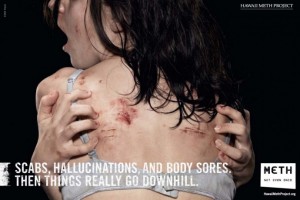Hawaii increasingly aware of methamphetamine risks
A survey conducted by the Hawaii Meth Project shows significant shifts in attitudes toward meth drug use. According to the survey, 54% of Hawaii teens and 67% of young adults now see great risk in taking meth once or twice, up 10 points for each group from a year ago. The Hawaii Meth Project this week unveiled the second wave of its statewide public education messaging campaign. The projects commercials and advertisements graphically depict the real physical and emotional consequences of Meth or ice addiction.
The media campaign also includes community outreach conducted in partnership with local coalitions, prevention and treatment partners, law enforcement, and state and local governments.
The 2010 Hawaii Meth Use & Attitudes Survey was compared to results from a benchmark survey conducted a year earlier, before the launch of the Hawaii Meth Project’s statewide prevention campaign.
Hawaii’s young people are increasingly aware of the risks of using Meth, strongly disapprove of taking the drug even once or twice, and teens are more likely to discuss the subject with their parents. The data also shows that increasing numbers of teens and young adults say their friends would give them a hard time for using Meth.
The survey also shows that since the launch of the Hawaii Meth Project there is increasing disapproval of Meth use, as 87% of young adults now report they strongly disapprove of trying Meth even once or twice, up 6 points from the 2009 benchmark. Hawaii teens and young adults are also now more likely to voice this disapproval—67% of teens (up 11 points) and 82% of young adults (up 7 points) say their friends would give them a hard time for using Meth. In addition, 54% of teens (up 6 points) say they have discussed the subject of Meth with their parents in the past year.
“This research demonstrates we are making significant progress in our efforts to prevent Meth use among Hawaii’s young people,” said Dr. Kevin Kunz, President of the American Board of Addiction Medicine. “Teens and young adults are considerably more aware of the risks of methamphetamine, increasingly disapprove of its use, and are taking action by telling their friends not to try Meth. These changes in attitudes are key to reducing Meth use, so I am greatly encouraged by this new data.”
“Thanks to the efforts of the Hawaii Meth Project we are educating Hawaii’s young people about the dangers of methamphetamine use,” said State Senator and President of the Hawaii Senate Colleen Hanabusa. “Meth will destroy their health, rob them of their futures, and ruin the lives of those they care about most. The ads have sparked much-needed parent-child dialogue, which is key to preventing Meth use among teens.”
The 2010 Hawaii Meth Use & Attitudes Survey was conducted in March and April 2010 by GfK Roper Public Affairs & Corporate Communications. The survey used random samples of 1,035 teens (ages 12-17) who attended one of 29 randomly selected junior and senior high schools across Hawaii, both private and public, as well as a random sample of 372 young adults (ages 18-24), and 403 parents of 12-19 year-olds from across Hawaii.
The executive summary and complete survey report can be obtained from the Hawaii
Meth Project’s website at www.HawaiiMethProject.org/Research.










